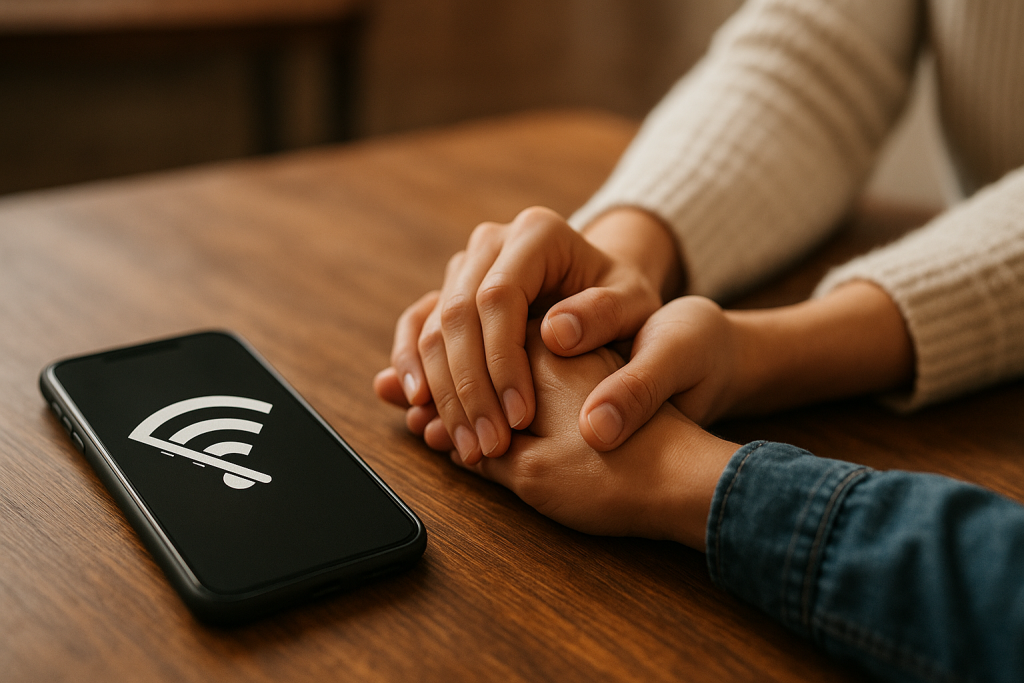In a time when nearly every aspect of our lives is tethered to screens, apps, and notifications, the role of disconnection in real connection is gaining attention. As digital fatigue sets in and people reassess the quality of their social and emotional interactions, an emerging trend is surfacing: deliberate disconnection. From tech-free retreats to scheduled “no screen” hours, many are rediscovering the value of stepping away in order to show up more meaningfully.
While our devices promise constant contact, they often compromise the depth and authenticity of those interactions. Disconnection, once seen as avoidance, is now being reframed as a powerful tool for cultivating attention, empathy, and human connection.

The Rise of Intentional Disconnection
Technology isn’t the problem—it’s the way we’ve let it dominate every corner of our time.
Some key developments pointing to this trend include:
- The popularity of digital detox apps like Freedom and OffScreen, which help users track and reduce screen time.
- Growth in “slow living” movements, which emphasize present-moment awareness and reduced dependency on instant communication.
- Employer-sponsored tech-free days, meant to boost creativity, reduce burnout, and foster real conversations.
According to a 2023 report by Pew Research Center, 61% of adults in the U.S. say they try to take breaks from their devices, and over 40% of them believe that doing so improves their relationships and attention span.
How Constant Connection Interferes with Real Relationships
Being reachable 24/7 has a downside—our availability often comes at the cost of attention. Here’s how:
- Surface-level engagement: Quick replies and emojis replace thoughtful conversation.
- Fragmented presence: We’re often multitasking—half in a meeting, half replying to texts, and not fully present in either.
- Social fatigue: Continuous updates from friends and strangers alike create a false sense of connection, without depth or intimacy.
In her book Reclaiming Conversation: The Power of Talk in a Digital Age, MIT professor Sherry Turkle argues that the very technologies designed to bring us closer are making conversations shallower and our emotional skills weaker.
The Benefits of Stepping Away
So what happens when you disconnect? For many, the result is a rebalancing of attention, clarity, and interpersonal depth.
Here are some key benefits:
- Improved listening
Without the lure of notifications, people engage more attentively in conversation. - Deeper empathy
Disconnection gives room to process thoughts and emotions—our own and others’. - Restored focus
Reconnection with real-world environments—through walking, reading, or shared silence—strengthens cognitive presence. - Stronger boundaries
Saying “no” to constant digital interaction encourages respect for mental and emotional space.
A University of Bath study (2022) found that participants who took a one-week break from social media reported significantly higher levels of wellbeing and life satisfaction.
Disconnection Practices That Strengthen Real Connection
If you want to see how disconnection can support your relationships, try integrating some of these practices:
1. Designate Tech-Free Zones
Start with meals, bedrooms, or walk-and-talks without phones. Physical boundaries lead to mental clarity.
2. Use “Airplane Mode” for Real-Life Moments
Want to be fully present at a birthday or coffee date? Airplane mode can make that easier, even if just for 30 minutes.
3. Schedule Disconnection Time
Treat offline time like an appointment. Weekly “no-screen Sundays” or post-dinner tech pauses can lead to more quality moments.
4. Practice Single-Tasking
When we do only one thing—like talking to someone without checking a screen—we allow room for the conversation to deepen naturally.
5. Reflect After Reconnection
After time offline, notice any changes in how you feel. Do you listen more patiently? Do you feel more grounded? This awareness helps reinforce the habit.
Why This Matters for a Digitally Saturated Generation
Younger generations, especially Gen Z and younger Millennials, are growing up in a world where digital connection is constant—but real connection is not guaranteed.
Even within mental health discussions, the trend toward disconnection for reconnection is gaining momentum. Apps like Headspace and Calm now include digital detox sessions, and wellness influencers regularly promote “dopamine resets” through screen breaks.
In workplaces, companies like Google and SAP have encouraged “deep work hours” and tech-free collaboration days to stimulate engagement.
The underlying belief? That to connect authentically with others, we sometimes need to disconnect first.
Navigating Disconnection in a Hyperconnected Culture
Disconnection doesn’t have to be radical or absolute. It’s about creating intentional space in a world that constantly asks for your attention.
Here are a few tips to navigate it without losing touch:
- Communicate boundaries: Let people know when you’ll be offline and why—it normalizes the practice.
- Use tools wisely: Apps that block social media or schedule phone-free time can support your goals.
- Be flexible: Not every disconnection will be perfect. What matters is consistency over perfection.
Conclusion: Disconnection Is Not the Enemy
We often equate connection with accessibility. But the role of disconnection in real connection is increasingly clear: when we step back, we make room for deeper presence.
Whether through intentional phone breaks, tech-free zones, or a quiet walk with someone, disconnection is proving to be more than a break—it’s a bridge.
As we move deeper into an age of digital everything, the people who will thrive aren’t necessarily the most connected, but the most selectively connected.
References
- Pew Research Center (2023) How Americans are trying to take breaks from their devices. Available at: https://www.pewresearch.org (Accessed: 24 June 2025).
- Turkle, S. (2015) Reclaiming Conversation: The Power of Talk in a Digital Age. Available at: https://www.sherryturkle.com (Accessed: 24 June 2025).
- Newport, C. (2019) Digital Minimalism: Choosing a Focused Life in a Noisy World. Available at: https://www.calnewport.com (Accessed: 24 June 2025).






